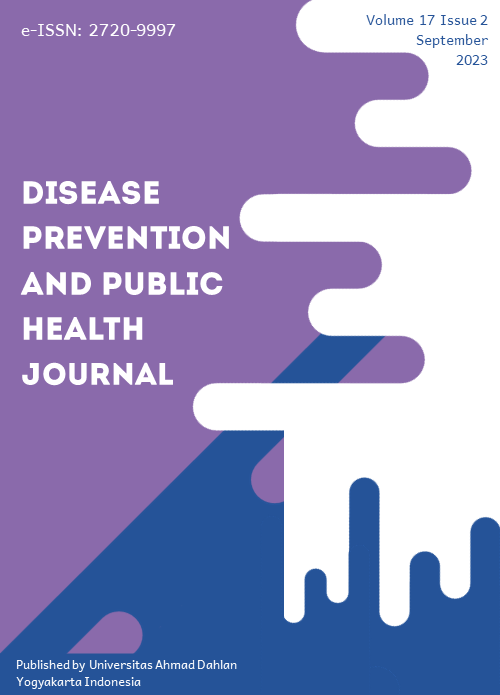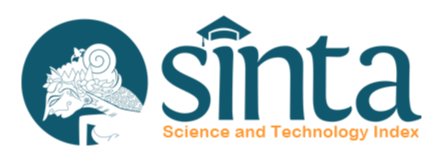Incomplete Immunization and Chronic Energy Deficiency (CED) as Risk Factors for Stunting in Toddlers
DOI:
https://doi.org/10.12928/dpphj.v17i2.8468Keywords:
Immunization, nutritional status, pregnant woman, stunting, chronic energy deficiencyAbstract
Background: Stunting is a problem caused by long-term malnutrition so that at the age of 24-59 months the physical manifestations are more visible. Completeness of immunization and nutritional status of pregnant women are aspects that are risk factors for stunting. The prevalence of stunting in 2020 in the world reached 22%, while in Indonesia it is 30.8%. The purpose of this study was to analyze the relationship between the completeness of immunization and the nutritional status of pregnant women with the incidence of stunting in children under five aged 24-59 months. Method: The research method with this type of observational analytic research is a case-control approach. The sample size is 178, the sample is taken by purposive sampling, using secondary data obtained at the Wilangan Health Center. Results: Based on the chi-square test, it was found that there was a relationship between the completeness of immunization and the incidence of stunting with a value of p<0.001 (OR=12.63) and there was a relationship between the nutritional status of pregnant women and the incidence of stunting with a value of p<0.001 (OR=13.58). The results of the logistic regression test analysis showed a p-value <0.001 on the completeness of immunization and nutritional status of pregnant women for stunting with OR values of 5.71 and 5.52 respectively. Conclusion: There is a significant relationship between the completeness of immunization and the nutritional status of pregnant women with the incidence of stunting.
References
Crotty JE, Martin-Herz SP, Scharf RJ. Cognitive Development. Pediatr Rev. 2023 Feb 1;44(2):58-67. doi: 10.1542/pir.2021-005069. PMID: 36720678.
Campbell BC. Editorial: Evolutionary Perspectives on Human Growth and Development. Front Endocrinol (Lausanne). 2021 Mar 17;12:672452. doi: 10.3389/fendo.2021.672452. PMID: 33815300; PMCID: PMC8010828.
Hijrawati, Usman AN, Syarif S, Hadju V, As'ad S, Baso YS. Use of technology for monitoring the development of nutritional status 1000 hpk in stunting prevention in Indonesia. Gac Sanit. 2021;35 Suppl 2:S231-S234. doi: 10.1016/j.gaceta.2021.10.028. PMID: 34929819.
Ogodescu E, Popa M, Luca M, Igna A, Miron M, Martha K, Tudor A, Todea C. Updating Standards of Facial Growth in Romanian Children and Adolescents Using the Anthropometric Method-A Pilot Study. Int J Environ Res Public Health. 2021 May 16;18(10):5288. doi: 10.3390/ijerph18105288. PMID: 34065693; PMCID: PMC8156684.
Laksono AD, Sukoco NEW, Rachmawati T, Wulandari RD. Factors Related to Stunting Incidence in Toddlers with Working Mothers in Indonesia. Int J Environ Res Public Health. 2022 Aug 26;19(17):10654. doi: 10.3390/ijerph191710654. PMID: 36078367; PMCID: PMC9518173.
Noor MS, Andrestian MD, Dina RA, Ferdina AR, Dewi Z, Hariati NW, Rachman PH, Setiawan MI, Yuana WT, Khomsan A. Analysis of Socioeconomic, Utilization of Maternal Health Services, and Toddler's Characteristics as Stunting Risk Factors. Nutrients. 2022 Oct 18;14(20):4373. doi: 10.3390/nu14204373. PMID: 36297057; PMCID: PMC9606970.
Azam M, Sulistiana R, Fibriana AI, Savitri S, Aljunid SM. Prevalence of Mental Health Disorders among Elderly Diabetics and Associated Risk Factors in Indonesia. Int J Environ Res Public Health. 2021 Sep 30;18(19):10301. doi: 10.3390/ijerph181910301. PMID: 34639601; PMCID: PMC8508332.
Eshete Tadesse S, Chane Mekonnen T, Adane M. Priorities for intervention of childhood stunting in northeastern Ethiopia: A matched case-control study. PLoS One. 2020 Sep 24;15(9):e0239255. doi: 10.1371/journal.pone.0239255. PMID: 32970709; PMCID: PMC7514084.
Mulyaningsih T, Mohanty I, Widyaningsih V, Gebremedhin TA, Miranti R, Wiyono VH. Beyond personal factors: Multilevel determinants of childhood stunting in Indonesia. PLoS One. 2021 Nov 19;16(11):e0260265. doi: 10.1371/journal.pone.0260265. PMID: 34797892; PMCID: PMC8604318.
Li Z, Kim R, Vollmer S, Subramanian SV. Factors Associated With Child Stunting, Wasting, and Underweight in 35 Low- and Middle-Income Countries. JAMA Netw Open. 2020 Apr 1;3(4):e203386. doi: 10.1001/jamanetworkopen.2020.3386. PMID: 32320037; PMCID: PMC7177203.
Lassi ZS, Rind F, Irfan O, Hadi R, Das JK, Bhutta ZA. Impact of Infant and Young Child Feeding (IYCF) Nutrition Interventions on Breastfeeding Practices, Growth and Mortality in Low- and Middle-Income Countries: Systematic Review. Nutrients. 2020 Mar 10;12(3):722. doi: 10.3390/nu12030722. PMID: 32164187; PMCID: PMC7146402.
Fatimah, Massi MN, Febriani ADB, Hatta M, Karuniawati A, Rauf S, Wahyuni S, Hamid F, Alasiry E, Patellongi I, Permatasari TAE, Farsida. The role of exclusive breastfeeding on sIgA and lactoferrin levels in toddlers suffering from Acute Respiratory Infection: A cross-sectional study. Ann Med Surg (Lond). 2022 Apr 26;77:103644. doi: 10.1016/j.amsu.2022.103644. PMID: 35638033; PMCID: PMC9142618.
Low DW, Jamil A, Md Nor N, Kader Ibrahim SB, Poh BK. Food restriction, nutrition status, and growth in toddlers with atopic dermatitis. Pediatr Dermatol. 2020 Jan;37(1):69-77. doi: 10.1111/pde.14004. Epub 2019 Oct 30. PMID: 31667896.
Aleksenko L, Åkerström B, Hansson E, Erlandsson L, Hansson SR. Pregnant alpha-1-microglobulin (A1M) knockout mice exhibit features of kidney and placental damage, hemodynamic changes and intrauterine growth restriction. Sci Rep. 2020 Nov 26;10(1):20625. doi: 10.1038/s41598-020-77561-6. PMID: 33244052; PMCID: PMC7691512.
Sartika AN, Khoirunnisa M, Meiyetriani E, Ermayani E, Pramesthi IL, Nur Ananda AJ. Prenatal and postnatal determinants of stunting at age 0-11 months: A cross-sectional study in Indonesia. PLoS One. 2021 Jul 14;16(7):e0254662. doi: 10.1371/journal.pone.0254662. PMID: 34260622; PMCID: PMC8279365.
M. G. Netea et al., “Defining trained immunity and its role in health and disease,” Nat. Rev. Immunol., vol. 20, no. 6, hal. 375–388, 2020, doi: 10.1038/s41577-020-0285-6.
R. N. Fajariyah dan A. C. Hidajah, “Correlation Between Immunization Status and Mother’S Height, and Stunting in Children 2–5 Years in Indonesia,” J. Berk. Epidemiol., vol. 8, no. 1, hal. 89–96, 2020, doi: 10.20473/jbe.v8i12020.89-96.
Pandya T, Joshi P, Pathak R, Shah S. Nano-vaccination Strategies: Applications and Challenges for Intranasal Immunization. Curr Pharm Biotechnol. 2023;24(8):946-969. doi: 10.2174/1389201023666220727105901. PMID: 35894466.
Ali A. Current Status of Malnutrition and Stunting in Pakistani Children: What Needs to Be Done? J Am Coll Nutr. 2021 Feb;40(2):180-192. doi: 10.1080/07315724.2020.1750504. Epub 2020 Apr 10. PMID: 32275484.
T. Beal, A. Tumilowicz, A. Sutrisna, D. Izwardy, dan L. M. Neufeld, “A review of child stunting determinants in Indonesia,” Matern. Child Nutr., hal. 1–10, 2018, doi: 10.1111/mcn.12617.
Luzingu JK, Stroupe N, Alaofe H, Jacobs E, Ernst K. Risk factors associated with under-five stunting, wasting, and underweight in four provinces of the Democratic Republic of Congo: analysis of the ASSP project baseline data. BMC Public Health. 2022 Dec 23;22(1):2422. doi: 10.1186/s12889-022-14842-x. PMID: 36564730; PMCID: PMC9783987.
J. Millward, “Nutrition, infection and stunting: The roles of deficiencies of individual nutrients and foods, and of inflammation, as determinants of reduced linear growth of children,” Nutr. Res. Rev., vol. 30, no. 1, hal. 50–72, 2017, doi: 10.1017/S0954422416000238.
Saleh A, Syahrul S, Hadju V, Andriani I, Restika I. Role of Maternal in Preventing Stunting: a Systematic Review. Gac Sanit. 2021;35 Suppl 2:S576-S582. doi: 10.1016/j.gaceta.2021.10.087. PMID: 34929905.
Baig MH, Ahmad K, Moon JS, Park SY, Ho Lim J, Chun HJ, Qadri AF, Hwang YC, Jan AT, Ahmad SS, Ali S, Shaikh S, Lee EJ, Choi I. Myostatin and its Regulation: A Comprehensive Review of Myostatin Inhibiting Strategies. Front Physiol. 2022 Jun 23;13:876078. doi: 10.3389/fphys.2022.876078. PMID: 35812316; PMCID: PMC9259834.
Bandyopadhyay S, Shivakumar N, Kurpad AV. Protein intakes of pregnant women and children in India-protein quality implications. Matern Child Nutr. 2020 Dec;16 Suppl 3(Suppl 3):e12952. doi: 10.1111/mcn.12952. PMID: 33347716; PMCID: PMC7752127.
Goudet SM, Bogin BA, Madise NJ, Griffiths PL. Nutritional interventions for preventing stunting in children (birth to 59 months) living in urban slums in low- and middle-income countries (LMIC). Cochrane Database Syst Rev. 2019 Jun 17;6(6):CD011695. doi: 10.1002/14651858.CD011695.pub2. PMID: 31204795; PMCID: PMC6572871.
Assaf S, Juan C. Stunting and Anemia in Children from Urban Poor Environments in 28 Low and Middle-income Countries: A Meta-analysis of Demographic and Health Survey Data. Nutrients. 2020 Nov 18;12(11):3539. doi: 10.3390/nu12113539. PMID: 33217992; PMCID: PMC7698615.
Lees CC, Romero R, Stampalija T, Dall'Asta A, DeVore GA, Prefumo F, Frusca T, Visser GHA, Hobbins JC, Baschat AA, Bilardo CM, Galan HL, Campbell S, Maulik D, Figueras F, Lee W, Unterscheider J, Valensise H, Da Silva Costa F, Salomon LJ, Poon LC, Ferrazzi E, Mari G, Rizzo G, Kingdom JC, Kiserud T, Hecher K. Clinical Opinion: The diagnosis and management of suspected fetal growth restriction: an evidence-based approach. Am J Obstet Gynecol. 2022 Mar;226(3):366-378. doi: 10.1016/j.ajog.2021.11.1357. Epub 2022 Jan 10. PMID: 35026129; PMCID: PMC9125563.
Nabwera HM, Mwangome MK, Prentice AM. Stunting of Growth in Developing Countries. World Rev Nutr Diet. 2022;125:14-27. doi: 10.1159/000521775. Epub 2022 Mar 4. PMID: 35249019.
Scheffler C, Hermanussen M, Bogin B, Liana DS, Taolin F, Cempaka PMVP, Irawan M, Ibbibah LF, Mappapa NK, Payong MKE, Homalessy AV, Takalapeta A, Apriyanti S, Manoeroe MG, Dupe FR, Ratri RRK, Touw SY, K PV, Murtani BJ, Nunuhitu R, Puspitasari R, Riandra IK, Liwan AS, Amandari P, Permatasari AAI, Julia M, Batubara J, Pulungan A. Stunting is not a synonym of malnutrition. Eur J Clin Nutr. 2020 Mar;74(3):377-386. doi: 10.1038/s41430-019-0439-4. Epub 2019 May 29. Erratum in: Eur J Clin Nutr. 2019 Oct 21;: PMID: 31142828.
Downloads
Published
Issue
Section
License
Copyright (c) 2023 Universitas Ahmad Dahlan

This work is licensed under a Creative Commons Attribution-ShareAlike 4.0 International License.
Authors transfer the copyright and grant the Disease Prevention and Public Health Journal right of first publication with the work simultaneously licensed under a Creative Commons Attribution License (CC BY-SA 4.0) that allows others to share (copy and redistribute the material in any medium or format) and adapt (remix, transform, and build upon the material) the work for any purpose, even commercially with an acknowledgement of the work's authorship and initial publication in Disease Prevention and Public Health Journal. Authors are able to enter into separate, additional contractual arrangements for the non-exclusive distribution of the journal's published version of the work (e.g., post it to an institutional repository or publish it in a book), with an acknowledgement of its initial publication in Disease Prevention and Public Health Journal. Authors are permitted and encouraged to post their work online (e.g., in institutional repositories or on their website) prior to and during the submission process, as it can lead to productive exchanges, as well as earlier and greater citation of published work (See The Effect of Open Access).

This work is licensed under a Creative Commons Attribution-ShareAlike 4.0 International License.







